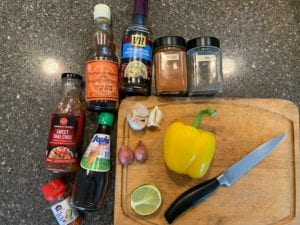Welcome back to the blog. This is my fifth blog post for In-Depth.
I cannot believe that In-Depth is almost in its final month. This blog post will be focusing on the most interesting meal I made over the last few weeks, Thai basil beef. I will try to show more than I tell while I explain this meal. But I will explain the steps I took and some of the skills I have learned.
As I said, this week I made Thai Beef Basil. I have attached the recipe below. It can be found at https://themodernproper.com/thai-basil-beef

We didn’t have any Thai basil left, so I substituted it for normal basil. I changed olive oil for sesame oil. I also chose to use palm sugar instead of brown sugar for a more traditional flavour. Below I have attached a photo of the ingredients.

Next, I set some rice to boil and started preparing my ingredients. In the next photo I prepped the garlic, pepper, and shallots.

Next, I prepped the palm sugar. I was going to cut it up like I have in the past, but my mom gave me the idea to crush it in the mortar and pestle. It worked incredibly well. The chunks of sugar quickly broke into fine dust.
Once the sugar was crushed, I started cooking the beef. As I have learned in the past, you want to first add oil, shallots, and garlic, then add the meat. This warms up the pan and combines the flavours before adding the meat. While the meat was cooking, I sprinkled basil and chili powder on to give the dish more spice.
Once the meat was cooked, I added the sliced peppers and basil, but I thought the dish looked boring. So, I looked around for more vegetables, but didn’t find anything interesting. I then noticed we had some pineapple. I diced that up and added it into the wok, under the assumption that it would add some extra sweetness to the meal. I also added the sauce that the recipe calls for.
Once everything was done cooking, I set the table. On the right is the rice. In the middle is the Thai Beef Basil and on the left is the leftover Thai soup from the weekend.

I also wanted to practice a new skill I had been learning called plating. Plating is pretty much arranging food in an artistic and appealing way. Research has shown that proper plating can enhance the taste and overall experience of eating a meal. I used a ¾ measuring cup to create the rice ball and added beef around it. Afterwards I added garnish like peppers, basil, and lime. For a final aesthetic boost, I added three drops of soy sauce and connected them with a fork.
I think it turned out very nice. This demonstrates my learning since the beginning of the project because I can now substitute ingredients and add new ingredients that change and enhance the meal. (The pineapple worked great) The pineapple added bright bursts of sweetness to the underlying heat, spice, and flavour of the chili powder.
I have also been told that I need to work on my plating skills. (This means that my family wants me to continue to practice plating food)
- What kinds of learning opportunities does the mentor provide to expose you to new learning?
An example of an opportunity my mentor has provided me with is new ingredients for cooking. For example, he gave me palm sugar to add a traditional sweetness to my cooking.
- What kinds of learning opportunities exist to reinforce new learning?
An opportunity to reinforce existing learning is making meals I have made in the past as a side dish. Recreating meals allows me to explore my latest ideas while also allowing me to focus on the main dish. A good example of this is rice. I make rice almost every time I cook, but I try different ideas while making it. For example, I tried adding lime juice to the water to give the rice more zest.
- What kinds of opportunities exist that might accelerate learning?
One way I could accelerate my learning is by watching Thai cooking shows. Watching Thai cooking shows would give me visual skill demonstrations and would expose me to new recipes, cooking styles, and ingrediants.
- When you get together what do you talk about?
When we meet, we mostly talk about my progress and my goals. If I have any outstanding challenges or struggles, we also talk about those.
- 5. What is going particularly well in your mentoring relationship right now?
One aspect of the mentoring relationship that is going well is the time he is giving me to explore. He lets me ask interesting questions and lets learn on my own until we get together at meetings.
- What are you learning about one another?
I am learning more about my mentor’s teaching style through this mentorship. He supports me when I need help but gives me time to explore. I cannot be sure what he has learned about me, but I think he has gotten to know me a little bit more.
